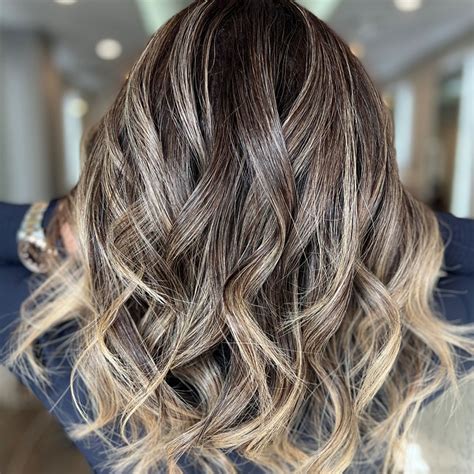Introduction
In the realm of hair transformations, balayage and highlights reign supreme as two widely sought-after techniques that add depth, dimension, and radiant shine to tresses. While both methods involve the application of color to the hair, they differ in their approach, execution, and resulting effects. This comprehensive guide delves into the nuances of balayage vs. highlights, empowering you with the knowledge to make an informed decision about the ideal hair-painting technique for your desired look.

Balayage
Inspired by the French word for “to sweep,” balayage mimics the natural lightening effect of the sun by hand-painting highlights onto sections of hair. This freehand technique creates soft, blended, and seamless color transitions that seamlessly blend with your natural hair color.
Key Characteristics:
- Hand-painted application: Balayage is meticulously applied by hand, allowing for precise placement of color.
- Natural-looking results: The goal of balayage is to achieve a sun-kissed, effortless look, resulting in subtle and flattering color graduations.
- Low maintenance: Balayage requires minimal touch-ups, typically lasting up to 6 months or more before requiring a refresh.
- Suitable for all hair types: Balayage can be customized to enhance the beauty of any hair texture, from fine to coarse.
Highlights
Highlights, also known as foiling, involve isolating strands of hair and wrapping them in aluminum foil before applying bleach or hair color. The foil acts as a barrier, creating sharp, well-defined streaks of color.
Key Characteristics:
- Foil-based application: The use of foil allows for precise separation and isolation of hair strands.
- Dramatic effects: Highlights create bold, contrasting color patterns that result in a more noticeable transformation.
- Higher maintenance: Foiled highlights tend to require more frequent touch-ups, typically every 6-8 weeks.
- Best suited for specific hair types: Highlights work best on hair that is naturally dark or medium-toned.
Balayage vs. Highlights: A Comparative Analysis
| Feature | Balayage | Highlights |
|---|---|---|
| Application Technique | Freehand painting | Foiling |
| Results | Natural-looking, blended | Bold, defined streaks |
| Maintenance | Low maintenance | High maintenance |
| Suitability for Hair Types | All hair types | Best for dark or medium hair |
| Ideal for Adding | Dimension, warmth | Contrast, brightness |
Pain Points and Motivations
Pain Points:
- Deciding between balayage and highlights can be challenging, especially if you are unsure of the desired look.
- The cost of hair-painting techniques can vary widely, impacting affordability.
- Finding a skilled and experienced stylist who can execute the technique flawlessly is crucial.
Motivations:
- Enhance the beauty of your hair with radiant color and dimension.
- Transform your look with a subtle or dramatic hair color change.
- Cover gray hairs or reduce the appearance of roots.
- Express your personal style and enhance your confidence.
Common Mistakes to Avoid
- Over-processing: Excessive bleaching or color application can damage hair, resulting in dryness, breakage, and dullness.
- Inconsistent application: Poor application technique can lead to uneven color distribution and visible demarcation lines.
- Ignoring hair care: Maintaining healthy hair is essential after any hair-coloring process. Regular conditioning, moisturizing, and protective treatments are recommended.
- Overlapping colors: Applying too many layers or overlapping colors can create an unnatural and unflattering look.
FAQs
1. Which technique is less damaging to hair?
- Balayage generally causes less damage than highlights due to its freehand application and reduced use of bleach.
2. How often should I get touch-ups?
- Balayage touch-ups are typically required every 6 months or more, while highlights may need touch-ups every 6-8 weeks.
3. Can I do balayage or highlights at home?
- It is not recommended to attempt balayage or highlights at home, as improper technique can lead to unsatisfactory results and potential hair damage. Consult a professional stylist to ensure optimal outcomes.
4. What is the cost difference between balayage and highlights?
- The cost of balayage and highlights can vary based on the stylist’s skill level, salon location, and hair length and thickness. Highlights tend to be more expensive than balayage.
5. Can I get balayage or highlights on colored hair?
- Yes, both balayage and highlights can be applied to previously colored hair. However, the stylist will need to assess the condition of your hair and determine the best approach.
6. Is balayage better for fine or thick hair?
- Balayage is suitable for all hair types, including both fine and thick hair. Skilled stylists can customize the technique to flatter the unique characteristics of your hair.
7. Can I get both balayage and highlights?
- Combining balayage and highlights is possible to create a more complex and customized color look. Consult your stylist to determine the best combination for your desired effect.
8. How long does balayage or highlights take?
- The time required for balayage or highlights varies depending on hair length, thickness, and the desired results. Generally, balayage takes longer than highlights due to its more detailed and freehand application.
Conclusion
Balayage and highlights are transformative hair-painting techniques that empower you to elevate your style and embrace a radiant, eye-catching look. By understanding the key differences, benefits, and considerations of each technique, you can make an informed decision to choose the perfect option for your individual needs and hair aspirations. Remember to seek the expertise of a skilled and experienced stylist to ensure a seamless and stunning transformation that complements your unique beauty.
